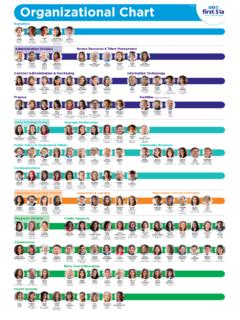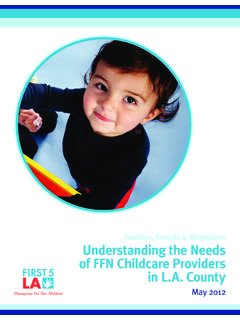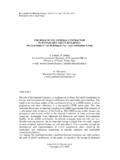Transcription of Partnerships For Families - First 5 LA
1 Stories and Lessons from Los Angeles CommunitiesPartnerships For FamiliesPartnerships For Families Stories and Lessons from Los Angeles CommunitiesTable of ConTenTsFor the Reader: Organization of the Report Chapter I. Introduction: Partnerships For Families I. Background: First 5 LA and Partnerships For Families II. The PFF Model III. Building a Comprehensive Network of Community Services and Supports: Core Components and Requirements of PFFIV. The Anchor Concepts of PFFC hapter II. Purpose and Design of the Case Study I. Overview of Existing PFF Research: What the Data Show II. Case Study Objectives III. The Role of the Center for the Study of Social Policy (CSSP) IV. Case Study Methodology Chapter III. Successful Collaboration: Relevant National Field Research Introduction I. What is Collaboration?
2 II. Successful Collaboration: Contributing Factors and Lessons Learned III. Readiness and Capacity-Building IV. Experiences and Lessons from the Field Conclusion: Implications for PFFC hapter IV. Parent Engagement: National Research and Experiences I. What is Parent Engagement and Why is it Important? II. Barriers to Parent Engagement III. Characteristics of Successful Parent Engagement ApproachesPaRtNERShIPS FOR Families : sTories and lessons from los angeles CommuniTiesChapter V. Profiles of PFF: Documenting Each Service Planning area s Unique Story Introduction SPA 1: Antelope Valley partnership For Families SPA 2: Project SAFE (Support and Advocacy for Family Empowerment) SPA 3: CARI O partnership For Families (Child Abuse Risk Intervention and Neighborhood Outreach) SPA 4: Partnerships For Families SPA 5: Partnerships For Families Collaborative SPA 6: Achieving Change Together SPA 7: Project Corazon partnership For Families SPA 8: The Family Support CollaborationChapter VI.
3 Lessons learned Introduction I. Readiness Factors A. Clear, Compelling and Shared Outcomes B. Local Context, History, and Experience Working Together C. Skilled Leadership: A Catalyst and Support D. Availability of Institutional Supports from the Beginning II. Development and Maintenance of Community-Based PFF Collaboratives A. Reaching Out to a Wide Range of Partners B. Developing Effective Roles and Collaborative Processes C. Commitment to Mutual and Continuous Learning III. Achieving and Sustaining Improvements Among At-Risk Families A. Engaging Parents and Other Family Members as Partners B. Focusing on Strengths C. Access to a Comprehensive Array of Services and Supports D. Culturally Respectful and Appropriate Practices IV. Common and Unique Factors that Impact PFF Implementation Across SPAs A.
4 A Learning Approach B. Collaboration C. Parent Engagement D. Institutional Supports ConclusionPaRtNERShIPS FOR Families : sTories and lessons from los angeles CommuniTiesChapter VII. Implications of PFF: Recommendations for Communities, Systems and Funders Introduction I. Implications for Place-Based Initiatives: Achieving Ambitious Outcomes in Targeted Neighborhoods II. Implications for Prevention: Evidence-Based Approaches in the Context of Community III. Implications for Public Child Welfare Systems: Partnering with Families and Communities to Protect Children IV. Implications for Policymakers and Funders: Maximizing Outcomes and Investments Conclusionappendices A. Glossary B. Acronyms C. Map of Los Angeles County Service Planning Areas D. Partnerships For Families Theory of Change E. Case Study Interview and Focus Group Questionnaires E-1.
5 PFF Administrators and Coordinators Questionnaire E-2. Community Partner Questionnaire E-3. Family Engagement Questionnaire E-4. Institutional Leaders and Supporters Questionnaire E-5. Parent Questionnaire F. Case Study Interview Protocols F-1. Case Study Interview Format F-2. Interview Request Form Letter F-3. Informed Consent Form and Participant Rights G. Summary of Interview and Focus Group Data CollectionH. Parent Engagement: Celebration Luncheon ReportI. Collaborative Partners J. List of PFF Collaborative Partners in Each Service Planning AreaPaRtNERShIPS FOR Families : sTories and lessons from los angeles CommuniTiesFor the Reader: Organization of the Report 1 Partnerships FOR Families : sTories and lessons from los angeles CommuniTiesThis report presents the findings of a case study of the First 5 LA initiative, Partnerships For Families .
6 The report consists of seven chapters:Chapter I Introduction describes the purpose of PFF, its design and core components, and the anchor concepts and principles that guide its development. Chapter II Purpose and Design of the Case Study presents the goals, design, and methodology of the case study. Instead of evaluating the initiative, the case study describes PFF implementation and implications. It draws on extensive interviews, focus groups, and materials to present the perspectives of various stake-holders, the challenges, successes, lessons learned, and implications for various audiences. Chapter III Successful Collaboration: Relevant National Field Research provides context for the col-laborative efforts of PFF partners by summarizing national research about community collaboration. From the research and a sample of community experiences, it describes the many ways that community groups work together, the conditions and strategies that contribute to successful collaboration, and lessons from the field.
7 Chapter IV Parent Engagement: National Research and Experiences uses a similar approach to briefly examine the national context for parent engagement efforts. It provides a synopsis of the experiences and lessons of service providers and communities nationwide, including definitions and types of parent engage-ment, barriers that parents and other residents experience, and characteristics of effective strategies. Chapter V Profiles of PFF: Documenting Each Service Planning Area s Unique Story features a concise profile of PFF implementation in each of the eight service areas of Los Angeles County. The heart of the case study, these profiles tell the story of collaborative groups working together to strengthen Families and keep children safe in the communities of Los Angeles. Each profile briefly outlines the community context within which the local PFF Collaborative operates, its strategies for collaboration and parent engagement, and the policy and system-level impact of its VI Emergent Themes and Lessons explores the themes and lessons that have emerged from PFF.
8 It addresses the case study s four objectives by synthesizing the range of experiences across local PFF Collaboratives, providing illustrative examples from the field, and analyzing the VII Implications of PFF: Considerations for Communities, Systems and Funders consid-ers the experiences and lessons of PFF in the context of national developments. The Center for the Study of Social Policy case study team explores the implications for multiple audiences: the prevention field, place-based initiatives, public child welfare systems, and policymakers and funders. The authors recommend op-tions for these audiences to consider as they work to improve outcomes for young children and their Families . For the Reader: Organization of the Report For the Reader: Organization of the Report 2 Partnerships FOR Families : sTories and lessons from los angeles CommuniTiesMany people and organizations contributed to each step of the case study from its inception to completion.
9 A key goal was to co-design the research project to ensure that it would be a useful, reflective process for all those involved in PFF including parent participants, frontline staff, community partners, lead agencies, First 5 LA staff and Commissioners, evaluators, and consultants. Mutual learning was a priority. Staff and consul-tants of the Center for the Study of Social Policy are the authors of this report and accept full responsibility for any omissions or flaws. Unless otherwise indicated, the opinions expressed are theirs alone. At the same time, the report is informed by the best thinking, diligent work, and profound commitment of many partners throughout Los Angeles County. Introduction: Partnerships For Families >> I. Background: First 5 la and Partnerships For Families 3 Partnerships FOR Families : sTories and lessons from los angeles CommuniTiesChapter I.
10 Introduction: Partnerships For FamiliesPartnerships For Families (PFF) is unique initiative funded by First 5 LA to prevent abuse and neglect of young children. Drawing from research regarding the risks for children and the factors that help protect them, the initia-tive aims to strengthen both Families and communities to ensure that young children thrive. In addition to promot-ing research-backed prevention programs, the initiative encourages the development of community networks of services and supports that can help parents nurture their children. PFF targets Families with children from birth through age 5 who are at high or very high risk of harm, as well as pregnant women with specific risk factors for child maltreatment. At the same time, many PFF supports and capacity-building activities are offered to all Families within participating initiative has achieved documented success.












